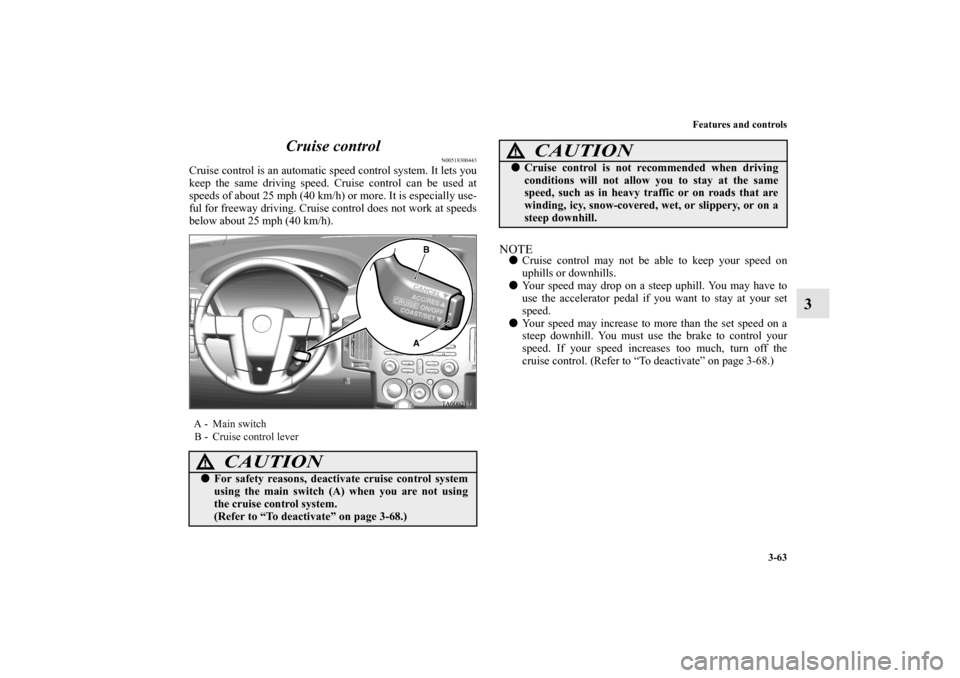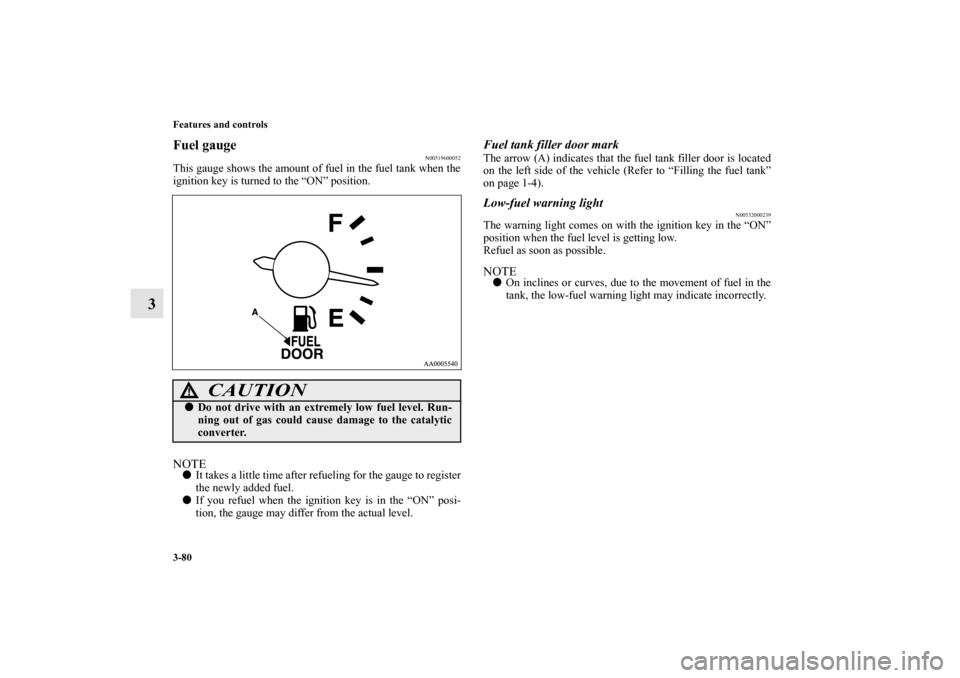Page 151 of 514
![MITSUBISHI ENDEAVOR 2010 1.G Owners Manual 3-62 Features and controls
3
[If the indicator alone illuminates]• Park your vehicle in a safe place and stop the
engine. Restart the engine again and check
whether the indicator goes out. If th MITSUBISHI ENDEAVOR 2010 1.G Owners Manual 3-62 Features and controls
3
[If the indicator alone illuminates]• Park your vehicle in a safe place and stop the
engine. Restart the engine again and check
whether the indicator goes out. If th](/manual-img/19/7427/w960_7427-150.png)
3-62 Features and controls
3
[If the indicator alone illuminates]• Park your vehicle in a safe place and stop the
engine. Restart the engine again and check
whether the indicator goes out. If the indicator
goes out, there is no abnormal condition.
If the indicator alone remains on even after
your vehicle is driven a short distance after
restarting the engine, have the vehicle inspected by
an authorized Mitsubishi Motors dealer or a
repair facility of your choice as soon as possible.CAUTION
!
CAUTION
!�If the front-wheel drive vehicle is towed with the
ignition key in the “ON” position and only the front
wheels or only the rear wheels raised off the ground,
the ASC may operate, resulting in an accident.
When towing the vehicle with the front wheels
raised, keep the ignition key in the “LOCK” or
“ACC” position. When towing the vehicle with the
rear wheels raised, keep the ignition key in the
“ACC” position.
Refer to “Towing” on page 6-23.
BK0102600US.book 62 ページ 2009年3月30日 月曜日 午後2時2分
Page 152 of 514

Features and controls
3-63
3 Cruise control
N00518300443
Cruise control is an automatic speed control system. It lets you
keep the same driving speed. Cruise control can be used at
speeds of about 25 mph (40 km/h) or more. It is especially use-
ful for freeway driving. Cruise control does not work at speeds
below about 25 mph (40 km/h).
NOTE�Cruise control may not be able to keep your speed on
uphills or downhills.
�Your speed may drop on a steep uphill. You may have to
use the accelerator pedal if you want to stay at your set
speed.
�Your speed may increase to more than the set speed on a
steep downhill. You must use the brake to control your
speed. If your speed increases too much, turn off the
cruise control. (Refer to “To deactivate” on page 3-68.)
A - Main switch
B - Cruise control lever
CAUTION
!�For safety reasons, deactivate cruise control system
using the main switch (A) when you are not using
the cruise control system.
(Refer to “To deactivate” on page 3-68.)
�Cruise control is not recommended when driving
conditions will not allow you to stay at the same
speed, such as in heavy traffic or on roads that are
winding, icy, snow-covered, wet, or slippery, or on a
steep downhill.
CAUTION
!
BK0102600US.book 63 ページ 2009年3月30日 月曜日 午後2時2分
Page 157 of 514
3-68 Features and controls
3
To deactivate
N00518800510
The cruise control can be turned off as follows:
1. Push the main switch (A) at the end of the lever.
(Main switch OFF)
2. Pull the cruise control lever (B) toward you.
3. By slightly tapping the brake pedal or pressing down on it
to slow your speed.
The cruise control is turned off automatically in any of the fol-
lowing ways:
1. When your speed slows to about 10 mph (15 km/h) or
more below the set speed because of a hill, etc.
2. When your speed slows to about 25 mph (40 km/h) or
less.3. When the active stability control starts (ASC) operating.
Refer to “Active stability control (ASC) system” on page
3-58.
WA R N I N G
!�Although the cruise control will be disengaged when
shifting to the “N” position, never move the selector
lever to the “N” position while driving.
You would have no engine braking and could cause
a serious accident.
BK0102600US.book 68 ページ 2009年3月30日 月曜日 午後2時2分
Page 159 of 514
3-70 Features and controls
3
NOTE�The tire pressure monitoring system is not a substitute for
regularly checking tire inflation pressures.
Be sure to check the tire inflation pressures as described in
“Tires” on page 7-20.�The tire inflation pressure sensor (A) is installed in the
illustrated location.
• On vehicles with Type 1 sensor which has the metallic
air valve (B), replace grommet (C) with a new one when
the tire is replaced.
• On vehicles with Type 2 sensor which has the rubber air
valve (D), replace rubber valve (D) and screw (E) with
new ones when the tire is replaced.
For details, please contact your authorized Mitsubishi
Motors dealer.
Ty p e 1
Ty p e 2
BK0102600US.book 70 ページ 2009年3月30日 月曜日 午後2時2分
Page 160 of 514

Features and controls
3-71
3
Tire pressure monitoring system warning light
N00554800064
When the ignition key is turned to the “ON” position, this light
normally illuminates and goes off a few seconds later. If one or
more of the vehicle tires is significantly under-inflated, how-
ever, this light will remain illuminated while the key is in the
“ON” position.
Refer to “If the warning light illuminates while driving” on
page 3-73 and take the necessary measures.NOTE�Tire pressure monitoring system doesn’t monitor the spare
tire in luggage room, even if the tire inflation pressure
sensor is equipped.
�Tire pressure monitoring system monitors the 18-inch alu-
minum spare tire when it is used.
CAUTION
!�If the tire pressure monitoring system warning light
does not illuminate when the ignition key is turned
to the “ON” position, it means that the tire pressure
monitoring system is not working properly. Have
the system inspected by an authorized Mitsubishi
Motors dealer.
In such situations, a malfunctioning of the system
may be preventing the monitoring of the tire pres-
sure. Avoid sudden braking, sharp turning and
high-speed driving.
�If a malfunction is detected in the tire pressure mon-
itoring system, the tire pressure monitoring system
warning light will blink for approximately 1 minute
and then remain continuously illuminated. The
warning light will issue further warnings each time
the engine is restarted as long as the malfunction
exists.
Check to see whether the warning light goes off after
few minutes of driving.
If it then goes off during driving, there is no prob-
lem.
However, if the warning light does not go off, or if it
blinks again when the engine is restarted, have the
vehicle inspected by an authorized Mitsubishi
Motors dealer.
In such situations, a malfunctioning of the system
may be preventing the monitoring of the tire pres-
sure. For safety reasons, when the warning light
appears while driving, avoid sudden braking, sharp
turning and high-speed driving.
CAUTION
!
BK0102600US.book 71 ページ 2009年3月30日 月曜日 午後2時2分
Page 162 of 514

Features and controls
3-73
3
If the warning light illuminates while driving
N00532800282
1. If the tire pressure monitoring system warning light illu-
minates, avoiding hard braking, sharp steering maneuvers
and high speeds. You should stop and adjust the tires to
the proper inflation pressure as soon as possible. Adjust
the spare tire at the same time. Refer to “Tires” on page 7-
20.NOTE�When inspecting or adjusting the tire pressure, do not
apply excessive force to the valve stem to avoid breakage.
�After inspecting or adjusting the tire pressure, always
reinstall the valve cap on the valve stem.
Without the valve cap, dirt or moisture could get into the
valve, resulting in damage to the tire inflation pressure
sensor.
�Do not use metal valve caps, which may cause a metal
reaction, resulting in corrosion and damage of the tire
inflation pressure sensors.
�Once adjustments have been made, the warning light will
go off after a few minutes of driving.
2. If the tire pressure monitoring system warning light
remains illuminated after you have been driving for about
20 minutes after you adjust the tire inflation pressure, one
or more of the tires may have a puncture. Inspect the tire
and if it has a puncture, have it repaired by an authorized
Mitsubishi Motors dealer as soon as possible.
NOTE�To avoid the risk of damage to the tire inflation pressure
sensors, have any punctured tire repaired by an authorized
Mitsubishi Motors dealer. If the tire repair is not done by
an authorized Mitsubishi Motors dealer, it is not covered
by your warranty.
�Do not use an aerosol puncture-repair spray on any tire.
Such a spray could damage the tire inflation pressure sen-
sors. Have any puncture repaired by an authorized Mit-
subishi Motors dealer.
WA R N I N G
!�If the tire pressure monitoring system warning light
illuminates while you are driving, avoid hard brak-
ing, sharp steering maneuvers and high speeds.
Driving with an under-inflated tire adversely affects
vehicle performance and can result in an accident.
CAUTION
!�If a tire has a puncture, replace that tire with the
spare tire. Driving on a punctured tire could lead to
an accident.�The tire pressure monitoring system warning light
may not illuminate immediately in the event of a tire
blowout or rapid leak.
SC00000300-3.fm 73 ページ 2009年7月3日 金曜日 午後2時10分
Page 169 of 514

3-80 Features and controls
3
Fuel gauge
N00519600052
This gauge shows the amount of fuel in the fuel tank when the
ignition key is turned to the “ON” position.NOTE�It takes a little time after refueling for the gauge to register
the newly added fuel.
�If you refuel when the ignition key is in the “ON” posi-
tion, the gauge may differ from the actual level.
Fuel tank filler door markThe arrow (A) indicates that the fuel tank filler door is located
on the left side of the vehicle (Refer to “Filling the fuel tank”
on page 1-4).Low-fuel warning light
N00532000239
The warning light comes on with the ignition key in the “ON”
position when the fuel level is getting low.
Refuel as soon as possible.NOTE�On inclines or curves, due to the movement of fuel in the
tank, the low-fuel warning light may indicate incorrectly.
CAUTION
!�Do not drive with an extremely low fuel level. Run-
ning out of gas could cause damage to the catalytic
converter.
BK0102600US.book 80 ページ 2009年3月30日 月曜日 午後2時2分
Page 170 of 514
Features and controls
3-81
3
Engine coolant temperature gauge
N00519700095
This gauge shows the engine coolant temperature. If the tem-
perature is low when the ignition key is turned to the “ON”
position, the indicator will remain at the “C” (cold) position
until the engine begins to warm up.
The indicator will normally stay near the center while driving,
but may rise slightly in stop-and-go traffic or when the engine
is under a heavy load.
CAUTION
!�Take care to keep the engine operating temperature
within the normal range while driving. If the indica-
tor enters the “H” (hot) position, the engine is over-
heating (Refer to “Engine overheating” on page 6-5).
BK0102600US.book 81 ページ 2009年3月30日 月曜日 午後2時2分